First Atlantic Nickel Expands RPM Zone Awaruite Nickel-Alloy (Ni₃Fe) Discovery: 400-Meter Northern Extension Yields 1.47% Nickel Concentrate Over 351 Meters in DTR Metallurgical Recovery Testing
First Atlantic Nickel (OTCQB: FANCF) announced significant expansion of its RPM Zone awaruite nickel-alloy discovery through drill hole AN-24-05, extending mineralization 400 meters north of the initial discovery. The hole yielded 1.47% nickel concentrate over 351 meters in Davis Tube Recovery (DTR) metallurgical testing, with an 8.21% mass pull.
Phase 1 drilling has defined a 400m x 500m mineralized area, with all four holes intersecting consistent awaruite mineralization. Concentrate grades ranged from 1.32% to 1.47% nickel, with mass pulls between 8.21% and 9.53%. The RPM Zone discovery is part of a 30km long ultramafic nickel belt within the Pipestone Ophiolite Complex.
Phase 2 drilling is currently underway to expand the mineralized footprint, with all Phase 1 holes ending in mineralization and remaining open in all directions. The discovery's significance is enhanced by awaruite's potential as a sulfur-free, environmentally friendly nickel source that can be processed without smelting.
First Atlantic Nickel (OTCQB: FANCF) ha annunciato una significativa espansione della sua scoperta di awaruite, una lega di nichel, nella zona RPM tramite il foro di sondaggio AN-24-05, estendendo la mineralizzazione di 400 metri verso nord rispetto alla scoperta iniziale. Il foro ha prodotto un concentrato di nichel all'1,47% su 351 metri nei test metallurgici di Davis Tube Recovery (DTR), con un recupero di massa dell'8,21%.
La fase 1 di perforazione ha definito un'area mineralizzata di 400m x 500m, con tutti e quattro i fori che hanno intercettato una mineralizzazione costante di awaruite. I gradi del concentrato variavano da 1,32% a 1,47% di nichel, con recuperi di massa tra l'8,21% e il 9,53%. La scoperta nella zona RPM fa parte di una fascia ultramafica di nichel lunga 30 km all'interno del Complesso Ophiolite di Pipestone.
La fase 2 di perforazione è attualmente in corso per ampliare l'area mineralizzata, con tutti i fori della fase 1 che terminano in mineralizzazione e rimangono aperti in tutte le direzioni. L'importanza della scoperta è accentuata dal potenziale dell'awaruite come fonte di nichel priva di zolfo, ecologica e che può essere lavorata senza fusione.
First Atlantic Nickel (OTCQB: FANCF) anunció una expansión significativa de su descubrimiento de aleación de níquel awaruite en la Zona RPM mediante el pozo de perforación AN-24-05, extendiendo la mineralización 400 metros hacia el norte del hallazgo inicial. El pozo produjo un concentrado de níquel del 1,47% sobre 351 metros en pruebas metalúrgicas Davis Tube Recovery (DTR), con una recuperación de masa del 8,21%.
La fase 1 de perforación definió un área mineralizada de 400m x 500m, con los cuatro pozos intersectando mineralización consistente de awaruite. Los grados de concentrado oscilaron entre 1,32% y 1,47% de níquel, con recuperaciones de masa entre 8,21% y 9,53%. El descubrimiento en la Zona RPM forma parte de una franja ultramáfica de níquel de 30 km de longitud dentro del Complejo Ofiolítico Pipestone.
Actualmente se está llevando a cabo la fase 2 de perforación para ampliar la huella mineralizada, con todos los pozos de la fase 1 terminando en mineralización y permaneciendo abiertos en todas las direcciones. La importancia del descubrimiento se ve reforzada por el potencial de la awaruite como una fuente de níquel libre de azufre, ecológica y que puede procesarse sin fundición.
First Atlantic Nickel (OTCQB: FANCF)는 드릴홀 AN-24-05를 통해 RPM 존의 아와루이트 니켈 합금 발견을 크게 확장했다고 발표했으며, 초기 발견 지점에서 북쪽으로 400미터 광물화가 확장되었습니다. 이 구멍은 Davis Tube Recovery(DTR) 야금 시험에서 351미터 구간에서 1.47% 니켈 농축물을 산출했으며, 8.21%의 질량 회수를 기록했습니다.
1단계 시추는 400m x 500m 광물화 구역을 정의했으며, 네 개의 시추공 모두 일관된 아와루이트 광물화를 관통했습니다. 농축물 등급은 1.32%에서 1.47% 니켈 사이였고, 질량 회수율은 8.21%에서 9.53% 사이였습니다. RPM 존 발견은 Pipestone 오피올라이트 복합체 내의 30km 길이의 초염기성 니켈 벨트의 일부입니다.
2단계 시추가 현재 진행 중이며, 1단계 시추공 모두 광물화 구간에서 종료되어 모든 방향으로 개방되어 있어 광물화 범위를 확장할 계획입니다. 이 발견의 중요성은 아와루이트가 황이 없는 친환경 니켈 원료로서 제련 없이도 가공할 수 있다는 잠재력에 의해 더욱 부각됩니다.
First Atlantic Nickel (OTCQB : FANCF) a annoncé une expansion significative de sa découverte d'alliage de nickel awaruite dans la zone RPM grâce au forage AN-24-05, étendant la minéralisation de 400 mètres vers le nord de la découverte initiale. Le forage a produit un concentré de nickel à 1,47 % sur 351 mètres lors des tests métallurgiques Davis Tube Recovery (DTR), avec un rendement en masse de 8,21 %.
Le forage de la phase 1 a défini une zone minéralisée de 400m x 500m, avec les quatre forages interceptant une minéralisation cohérente d'awaruite. Les teneurs en concentré variaient de 1,32 % à 1,47 % de nickel, avec des rendements en masse allant de 8,21 % à 9,53 %. La découverte de la zone RPM fait partie d'une ceinture ultramafique de nickel de 30 km de long au sein du complexe ophiolitique de Pipestone.
Le forage de la phase 2 est en cours pour étendre l'empreinte minéralisée, tous les forages de la phase 1 se terminant dans la minéralisation et restant ouverts dans toutes les directions. L'importance de la découverte est renforcée par le potentiel de l'awaruite en tant que source de nickel sans soufre, écologique, pouvant être traitée sans fusion.
First Atlantic Nickel (OTCQB: FANCF) gab eine bedeutende Erweiterung seiner Entdeckung der awaruithaltigen Nickellegierung in der RPM-Zone durch das Bohrloch AN-24-05 bekannt, wodurch die Mineralisierung um 400 Meter nach Norden der ursprünglichen Entdeckung erweitert wurde. Das Bohrloch ergab 1,47% Nickelkorn über 351 Meter bei Davis Tube Recovery (DTR) metallurgischen Tests mit einer Massenrückgewinnung von 8,21%.
Die Phase-1-Bohrungen definierten ein 400m x 500m mineralisiertes Gebiet, wobei alle vier Bohrlöcher konsistente awaruithaltige Mineralisierung durchschneiden. Die Konzentrate enthielten 1,32% bis 1,47% Nickel mit Massenrückgewinnungen zwischen 8,21% und 9,53%. Die Entdeckung der RPM-Zone ist Teil eines 30 km langen ultramafischen Nickelbands innerhalb des Pipestone-Ophiolith-Komplexes.
Die Phase-2-Bohrungen sind derzeit im Gange, um den mineralisierten Bereich zu erweitern, wobei alle Phase-1-Bohrlöcher in Mineralisierung enden und in alle Richtungen offen bleiben. Die Bedeutung der Entdeckung wird durch das Potenzial von Awaruit als schwefelfreie, umweltfreundliche Nickequelle, die ohne Schmelzen verarbeitet werden kann, verstärkt.
- Discovery extended 400 meters north with consistent high-grade nickel mineralization of 1.47% over 351 meters
- All four Phase 1 drill holes ended in mineralization, indicating significant expansion potential
- Awaruite can be processed into high-grade concentrates (>60% nickel) without smelting, meeting clean processing requirements
- Project located within 30km long nickel belt, suggesting district-scale potential
- Total nickel recovery rate of 50.26% indicates significant portion of nickel is not magnetically recoverable
- Relatively low DTR nickel grade of 0.12% compared to conventional nickel deposits
GRAND FALLS-WINDSOR, Newfoundland and Labrador, July 09, 2025 (GLOBE NEWSWIRE) -- First Atlantic Nickel Corp. (TSXV: FAN) (OTCQB: FANCF) (FSE: P21) ("First Atlantic" or the "Company") is pleased to announce positive Davis Tube Recovery (DTR) metallurgical test results from drill hole AN-24-05, the final hole completed during the Phase 1 drilling at the RPM Zone, part of its district scale Atlantic Nickel Project (the "Project"). Drill hole AN-24-05 returned a continuous interval of 351 meters averaging
Phase 2 drilling is currently underway, building on the success of Phase 1, which already defined a 400-meter by 500-meter area of awaruite nickel mineralization. All four holes drilled at the RPM Zone in Phase 1 intersected disseminated awaruite mineralization, returning consistent nickel grades and recoveries. Concentrate grades from these holes ranged from
Highlights:
- AN-24-05 Extends RPM Zone 400 Meters North, Confirming Continuity of Awaruite Mineralization: Drill hole AN-24-05, the fourth hole completed during the Phase 1 drill program at the RPM Zone, extends the drill-defined mineralization approximately 400 meters north of the initial discovery hole (AN-24-02). The results confirm the continuity of widespread disseminated awaruite nickel mineralization within the RPM Zone.
- Metallurgical Testing of AN-24-05 Returns
1.47% Nickel Concentrate Over 351 Meters: Davis Tube Recovery (DTR) testing of the 351meter mineralized interval in AN-24-05 returned a nickel grade of1.47% in magnetic concentrate, with a mass pull of8.21% . This equates to a magnetically recoverable DTR nickel grade of0.12% . The total nickel recovery was50.26% from a head grade of0.24% total nickel, highlighting the effectiveness of magnetic separation as a metallurgical process for upgrading awaruite nickel mineralization. - Phase 1 Drilling Expands Awaruite Nickel Discovery at RPM Zone: The Phase 1 drill program has delineated an initial mineralized zone measuring 400 x 500 meters. All four holes within the RPM Zone intersected significant awaruite nickel mineralization, returning consistently high DTR concentrate grades ranging from
1.32% to1.47% nickel and mass pulls of8.21% to9.53% . These results yielded magnetically recoverable DTR nickel grades between0.11% to0.14% , establishing a strong foundation for Phase 2 expansion drilling. - RPM Zone Discovery Highlights District-Scale Potential of Atlantic Nickel Project: The RPM Zone discovery occurs within a 30 km long, highly magnetic ultramafic nickel belt known as the Pipestone Ophiolite Complex. The zone is located approximately 25 kilometers south of historic awaruite nickel-alloy (Ni₃Fe) mineralization identified by Altius Resources and Cliffs Natural Resources in 2010 at the Atlantic Lake Zone. Average DTR nickel grades of
0.11% to0.14% from the RPM Zone demonstrate the potential for district-scale awaruite mineralization within multiple target areas of the project. - Phase 2 Exploration and Expansion Drilling Underway to Expand RPM Mineralized Footprint: The Phase 2 drilling campaign is currently underway, utilizing a systematic grid-based drill plan designed to step out from the Phase 1 footprint. The program aims to expand the RPM Zone's mineralized area and further define the extent of awaruite nickel mineralization.
RPM ZONE DRILL HOLE AN-24-05 RESULTS
Table 1: DTR Metallurgical Test Results Summary - Drill Hole AN-24-05 (RPM Zone)
| Parameter | Average | Maximum | Drill Length |
| Nickel - Magnetic Concentrate Grade (Davis Tube Recovery Concentrate assayed by XRF-Fusion) | 1.47% | 351m | |
| Chromium - Magnetic Concentrate Grade (Davis Tube Recovery Concentrate assayed by XRF-Fusion) | 1.53% | 351m | |
| Mass Pull (Magnetic Concentrate mass as % of Davis Tube test starting mass) | 8.21% | 351m | |
| Total Nickel Grade (Whole Rock ICP-OES assay) | 0.24% | 351m | |
| DTR Nickel Grade - Magnetically Recovered Nickel (Calculated with Davis Tube Recovery method) | 0.12% | 351m | |
| Total Nickel Recovery Magnetically Recovered Nickel as a Percentage of Total Nickel Content (from Whole Rock Assay Analysis) | 50.26% | 351m |
The Company's final drill hole from the Phase 1 program at the RPM zone, AN-24-05, has returned positive DTR metallurgical test results that extend the known awaruite mineralization approximately 400 meters to the north of the initial RPM Zone discovery hole (AN-24-02). Drill hole AN-24-05 intersected 351 meters of awaruite mineralization averaging
With the completion of AN-24-05, Phase 1 drilling has delineated an initial mineralized footprint measuring approximately 400-meters by 500-meters. All four holes from the program successfully intersected broad zones of disseminated awaruite-bearing nickel mineralization. The metallurgical results are notably consistent across all holes, indicating uniform nickel alloy mineralization hosted within ultramafic host rocks and strong lateral continuity of the mineralization system, which remains open in all directions and at depth. Across the RPM Zone, Phase 1 drilling returned magnetic concentrate grades ranging from
Table 2: DTR Metallurgical Test Results Summary from Drill Hole AN-24-05 (RPM Zone)
| Hole ID | From (m) | To (m) | Interval (m) | Mass Pull (%) | Nickel - Magnetic Concentrate Grade Ni (%) | Nickel - Total Grade Ni (%) | DTR Nickel Grade - Magnetically Recovered Ni (%) | Total Nickel Recovery (%) | Chromium - Magnetic Concentrate Grade Cr (%) | Chromium Total Grade Cr (%) | DTR Chromium Grade - Magnetically Recovered Cr (%) | Cobalt - Magnetic Concentrate Grade Co (%) |
| Hole AN-24-05 | 6 | 357 | 351 | 8.21 | 1.47 | 0.24 | 0.12 | 1.53 | 0.29 | 0.12 | 0.06 | |
| including | 6 | 207 | 201 | 8.36 | 1.39 | 0.23 | 0.12 | 1.58 | 0.30 | 0.13 | 0.07 | |
| including | 207 | 309 | 102 | 7.82 | 1.76 | 0.24 | 0.14 | 1.50 | 0.27 | 0.12 | 0.07 | |
| including | 309 | 357 | 48 | 8.32 | 1.18 | 0.24 | 0.10 | 1.39 | 0.29 | 0.11 | 0.05 | |
| Including "up to" | 10.90 | 2.61 | 0.29 | 0.17 | 2.88 | 0.55 | 0.28 | 0.09 | ||||
Table 3: RPM Phase 1 DTR Metallurgical Results Summary
| Drill hole | Interval (m) | Magnetic Concentrate Nickel Percent Grade | Mass Pull (%) | Magnetically Recoverable Nickel Grade (DTR Ni%) | Drill Ended in Mineralization |
| AN-24-02 | 383 | 9.49 | 0.13 | YES | |
| AN-24-03 | 216 | 9.12 | 0.11 | YES | |
| AN-24-04 | 366 | 9.53 | 0.14 | YES | |
| AN-24-05 | 357 | 8.21 | 0.12 | YES |
Note: DTR Nickel Grade (%) is a derived parameter calculated by multiplying the nickel grade of the magnetic concentrate (determined by XRF-Fusion assay) by the mass pull percentage, which is calculated by dividing the weight of the magnetic concentrate by the initial sample weight. Magnetically Recoverable Nickel (DTR Ni %) represents the amount of nickel in the sample that can be recovered using magnetic separation. For a visual explanation of the Davis Tube Recovery process, see: https://www.youtube.com/watch?v=q3zsgDtLWns
Table 4: AN-24-05 Drill Hole Collar Location Information
| Hole ID | Easting (UTM) | Northing (UTM) | Elevation (m) | Azimuth (°) | Dip (°) | Depth (m) |
| AN-24-05 | 567322 | 5357995 | 230 | 90 | -60 | 402 |
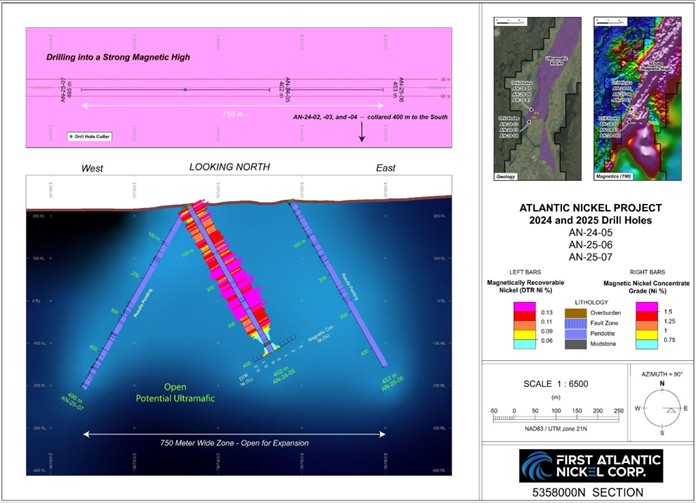
Figure 1: Cross-sectional view of the RPM Zone Hole AN-24-05 located 400 meters north of discovery hole AN-24-02. Showing the distribution of magnetic concentrate and DTR nickel values. Drill hole AN-24-05 averages
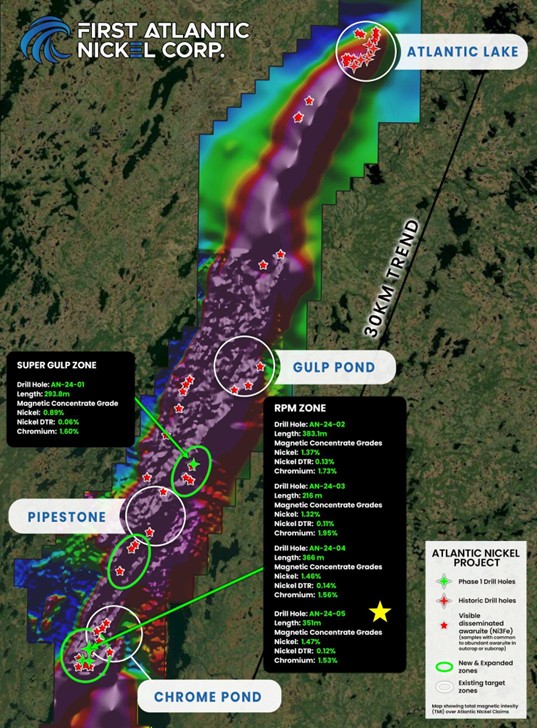
Figure 2: Map of the 30-kilometer-long nickel trend within the Pipestone Ophiolite Complex, illustrating the locations of Phase 1 drill holes (AN-24-01 through AN-24-05) and corresponding nickel and chromium assay results. The map highlights the spatial distribution of mineralized intercepts and outlines key target areas.
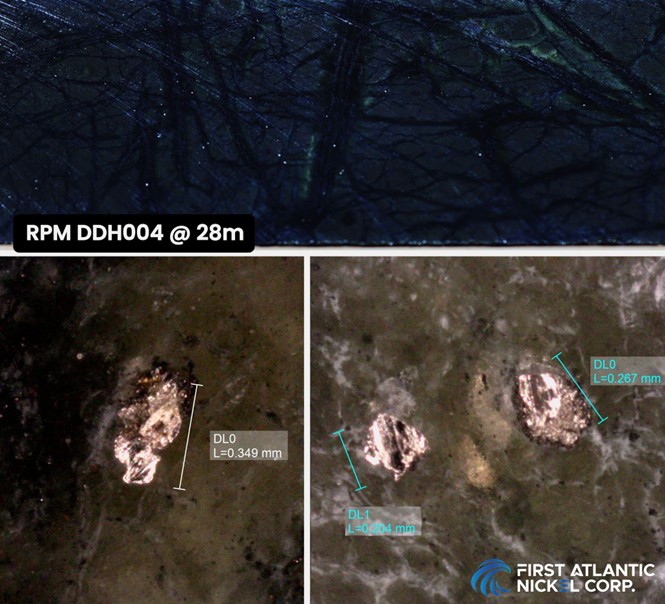
Figure 3: Drill Core and Microscopic Images – AN-24-05 at 28 Meters Depth (RPM Zone). Top image: Drill core from hole AN-24-05 at 28 meters depth showing disseminated awaruite (sulfur-free nickel-iron alloy) hosted in serpentinized peridotite with associated magnetite veining. Bottom images: Microscopic images of awaruite grains from the same interval, with individual grains measuring up to 349 microns.
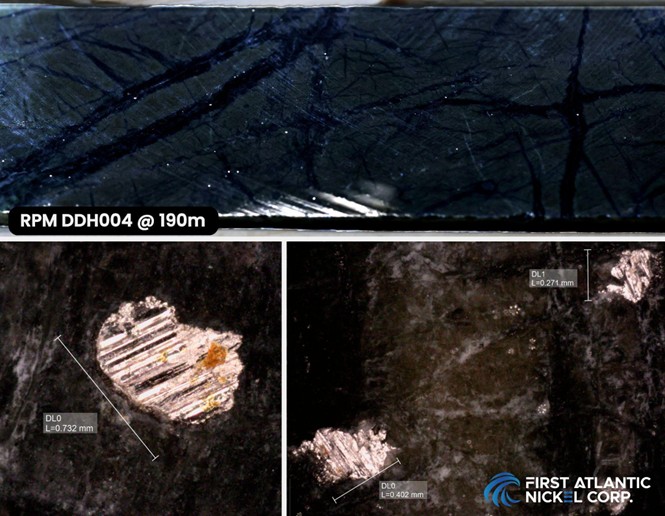
Figure 4: Drill Core and Microscopic Images – AN-24-05 at 190 Meters Depth (RPM Zone). Top image: Drill core from hole AN-24-05 at 190 meter depth showing disseminated awaruite (a sulfur-free nickel alloy) hosted in serpentinized ultramafic peridotite within the RPM Zone. Bottom images: Microscopic images of awaruite grains from the same depth, measuring up to 732 microns. Saw blade streaks are visible across the grains, illustrating the ductile and highly-magnetic properties of awaruite.
PHASE 2 DRILLING UNDERWAY TO EXPAND RPM ZONE MINERALIZATION
Phase 2 drilling is actively underway at the RPM Zone, with a program strategically designed to expand the current mineralized footprint beyond the approximately 400-meter length by 500-meter width area defined by the initial Phase 1 drill holes. Strategic step-out drilling at greater depths is now actively testing further expansion of mineralization in all directions - north toward Pipestone Pond, east toward Chrome Pond, and west into the RPM fault zone. Results from drill hole AN-24-05 highlight the strong potential for further expansion, with consistent DTR grades encountered throughout the hole, ending in mineralization. These findings indicate that the mineralized awaruite system extends further north, making the area towards Pipestone Pond a high-priority target.
The fully funded Phase 2 program is further supported by upgraded project infrastructure, including improved road access and expanded camp facilities. In addition, equipment optimizations have enabled deeper drilling capabilities, enhancing the Company’s ability to test the full vertical and lateral extent of the mineralized system. Together, these advancements position the Phase 2 campaign to meaningfully grow the RPM Zone's known mineralized footprint across in all target directions.
Awaruite (Nickel-iron alloy Ni₂Fe, Ni₃Fe)
Awaruite, a naturally occurring sulfur-free nickel-iron alloy composed of Ni₃Fe or Ni₂Fe with approximately ~
The U.S. Geological Survey (USGS) highlighted awaruite's potential, stating, "The development of awaruite deposits in other parts of Canada may help alleviate any prolonged shortage of nickel concentrate. Awaruite, a natural iron-nickel alloy, is much easier to concentrate than pentlandite, the principal sulfide of nickel"3. Awaruite's unique properties enable cleaner and safer processing compared to conventional sulfide and laterite nickel sources, which often involve smelting, roasting, or high-pressure acid leaching that can release toxic sulfur dioxide, generate hazardous waste, and lead to acid mine drainage. Awaruite's simpler processing, facilitated by its amenability to magnetic processing and lack of sulfur, eliminates these harmful methods, reducing greenhouse gas emissions and risks associated with toxic chemical release, addressing concerns about the large carbon footprint and toxic emissions linked to nickel refining.
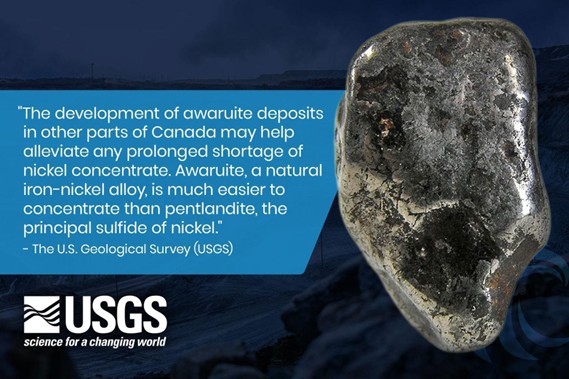
Figure 5: Quote from USGS on Awaruite Deposits in Canada
The development of awaruite resources is crucial, given China's control in the global nickel market. Chinese companies refine and smelt
Investor Information
The Company's common shares trade on the TSX Venture Exchange under the symbol "FAN", the American OTCQB Exchange under the symbol “FANCF” and on several German exchanges, including Frankfurt and Tradegate, under the symbol "P21".
Investors can get updates about First Atlantic by signing up to receive news via email and SMS text at www.fanickel.com. Stay connected and learn more by following us on these social media platforms:
https://x.com/FirstAtlanticNi
https://www.facebook.com/fanickelcorp
https://www.linkedin.com/company/firstatlanticnickel/
FOR MORE INFORMATION:
First Atlantic Investor Relations
Robert Guzman
Tel: +1 844 592 6337
rob@fanickel.com
Disclosure
Adrian Smith, P.Geo., a director and the Chief Executive Officer of the Company is a qualified person as defined by NI 43-101. The qualified person is a member in good standing of the Professional Engineers and Geoscientists Newfoundland and Labrador (PEGNL) and is a registered professional geoscientist (P.Geo.). Mr. Smith has reviewed and approved the technical information disclosed herein.
Analytical Method & QA/QC
Samples were split in half on site, with one half remaining in the core box for future reference and the other half securely packaged for laboratory analysis. The QA/QC protocol included the insertion of blanks, duplicates, and certified reference material (standards), with one QA/QC sample being inserted every 20 samples to monitor the precision and accuracy of the laboratory results. All analytical results successfully passed QA/QC screening at the laboratory, and all Company inserted standards and blanks returned results within acceptable limits.
Samples were submitted to Activation Laboratories Ltd. (“Actlabs”) in Ancaster, Ontario, an ISO 17025 certified and accredited laboratory operating independently of First Atlantic. Each sample was crushed, with a 250 g sub-sample pulverized to
The magnetic fractions are collected, dried, weighed and the magnetic fraction is fused with a lithium metaborate/tetraborate flux and lithium bromide releasing agent and then analyzed on a wavelength dispersive XRF for multiple elements including nickel, cobalt, iron and chromium. The magnetically recovered nickel grade was then calculated by multiplying the XRF fusion nickel value by the weight of the magnetic fraction and dividing by the total recorded feed weight or magnetic mass pulled from the sample.
True widths are currently unknown. However, the nickel bearing ultramafic ophiolite and peridotite rocks being targeted and sampled in the Phase 1 drilling program at the Atlantic Nickel Project are mapped as several hundred meters to over 1 kilometer wide and approximately 30 kilometers long.
About First Atlantic Nickel Corp.
First Atlantic Nickel Corp. (TSXV: FAN) (OTCQB: FANCF) (FSE: P21) is a Canadian mineral exploration company developing the
First Atlantic aims to be a key input of a secure and reliable North American critical minerals supply chain for the stainless steel and electric vehicle industries in the USA and Canada. The company is positioned to meet the growing demand for responsibly sourced nickel that complies with the critical mineral requirements for eligible clean vehicles under the US IRA. With its commitment to responsible practices and experienced team, First Atlantic is poised to contribute significantly to the nickel industry's future, supporting the transition to a cleaner energy landscape. This mission gained importance when the US added nickel to its critical minerals list in 2022, recognizing it as a non-fuel mineral essential to economic and national security with a supply chain vulnerable to disruption.
Neither the TSX Venture Exchange nor its Regulation Services Provider (as that term is defined in policies of the TSX Venture Exchange) accepts responsibility for the adequacy or accuracy of this release.
Forward-looking statements:
This news release may include "forward-looking information" under applicable Canadian securities legislation. Such forward-looking information reflects management's current beliefs and are based on a number of estimates and/or assumptions made by and information currently available to the Company that, while considered reasonable, are subject to known and unknown risks, uncertainties, and other factors that may cause the actual results and future events to differ materially from those expressed or implied by such forward-looking information.
Forward-looking information in this news release includes, but is not limited to: statements regarding: the timing, scope and results of the Company’s Phase 1 and Phase 2 work and drilling programs; future project developments; the Company’s objectives, goals, and future plans; statements and estimates of market conditions; the viability of magnetic separation as a low-impact processing method for awaruite; the strategic and economic implications of the Company’s projects; and expectations regarding future developments and strategic plans; Readers are cautioned that such forward-looking information are neither promises nor guarantees and are subject to known and unknown risks and uncertainties including, but not limited to, general business, economic, competitive, political and social uncertainties, uncertain and volatile equity and capital markets, lack of available capital, actual results of exploration activities, environmental risks, future prices of base and other metals, operating risks, accidents, labour issues, delays in obtaining governmental approvals and permits, and other risks in the mining and clean energy industries. Additional factors and risks including various risk factors discussed in the Company’s disclosure documents which can be found under the Company’s profile on http://www.sedarplus.ca. Should one or more of these risks or uncertainties materialize, or should assumptions underlying the forward-looking statements prove incorrect, actual results may vary materially from those described herein as intended, planned, anticipated, believed, estimated or expected.
The Company is presently an exploration stage company. Exploration is highly speculative in nature, involves many risks, requires substantial expenditures, and may not result in the discovery of mineral deposits that can be mined profitably. Furthermore, the Company currently has no mineral reserves on any of its properties. As a result, there can be no assurance that such forward-looking statements will prove to be accurate, and actual results and future events could differ materially from those anticipated in such statements. The Company undertakes no obligation to update forward-looking information, except as required by applicable securities laws.
1 https://fpxnickel.com/projects-overview/what-is-awaruite/
2 https://home.treasury.gov/news/press-releases/jy1939
3 https://d9-wret.s3.us-west-2.amazonaws.com/assets/palladium/production/mineral-pubs/nickel/mcs-2012-nicke.pdf
4 https://www.brookings.edu/wp-content/uploads/2022/08/LTRC_ChinaSupplyChain.pdf
5 https://web.archive.org/web/20250417033842/https://www.airuniversity.af.edu/JIPA/Display/Article/3703867/the-rise-of-great-mineral-powers/
6 https://home.treasury.gov/news/press-releases/jy1939
Photos accompanying this announcement are available at:
https://www.globenewswire.com/NewsRoom/AttachmentNg/36701655-da1d-44a0-98cc-647600547514
https://www.globenewswire.com/NewsRoom/AttachmentNg/bb141ee3-c657-4626-96c4-6a90af87f2ec
https://www.globenewswire.com/NewsRoom/AttachmentNg/8db25f62-6222-4c57-86dc-6942d1180eeb
https://www.globenewswire.com/NewsRoom/AttachmentNg/a83dc754-6fcc-4084-bc80-1955c896978d
https://www.globenewswire.com/NewsRoom/AttachmentNg/acc43c21-5095-4d9f-b90b-8a176dac8e34








